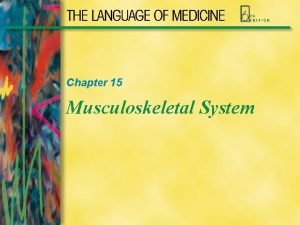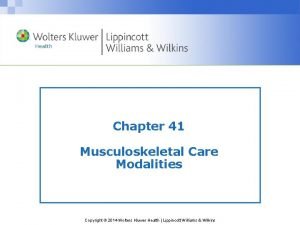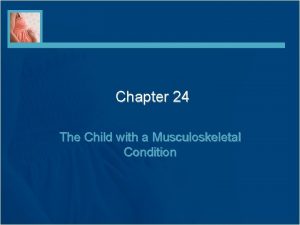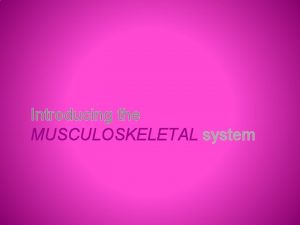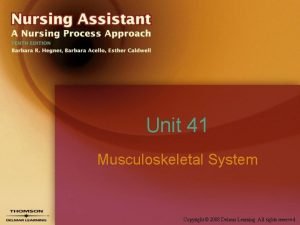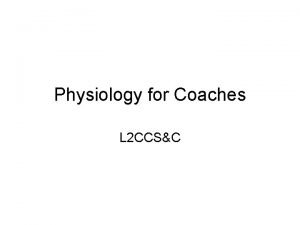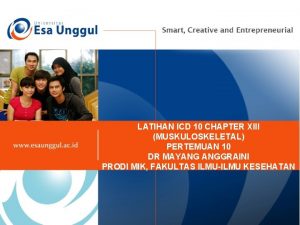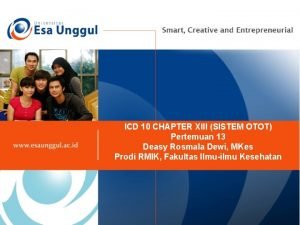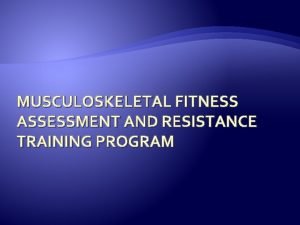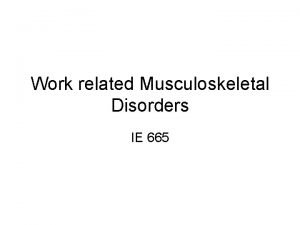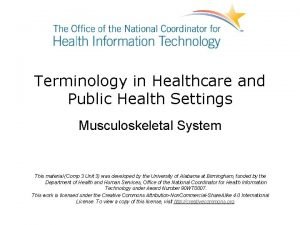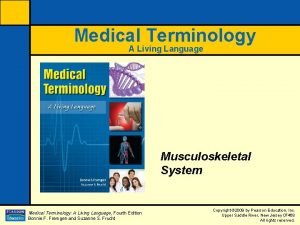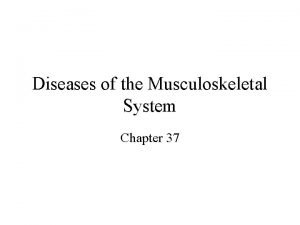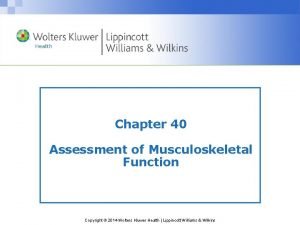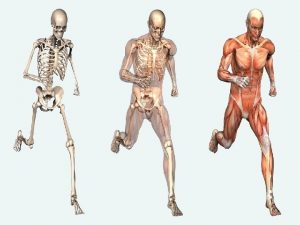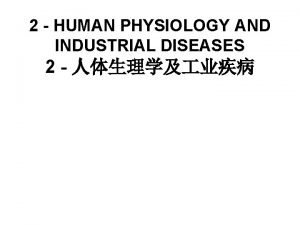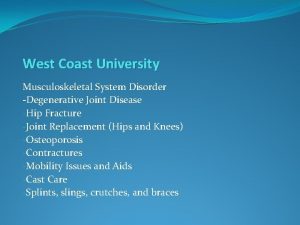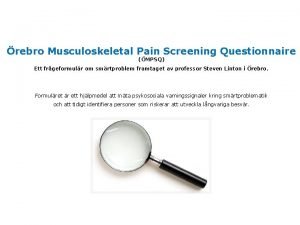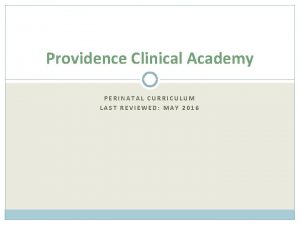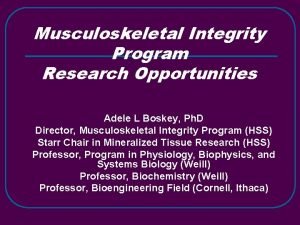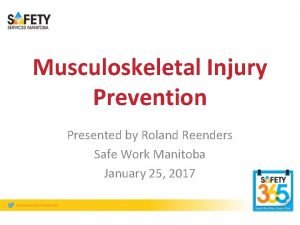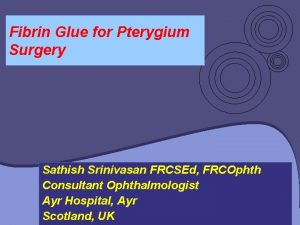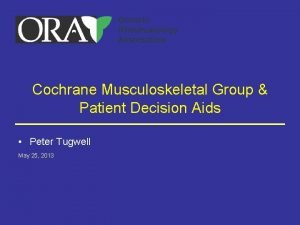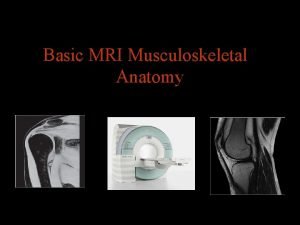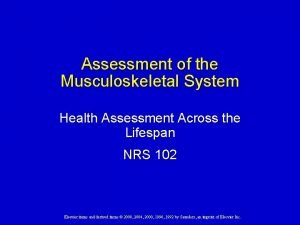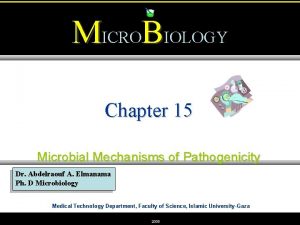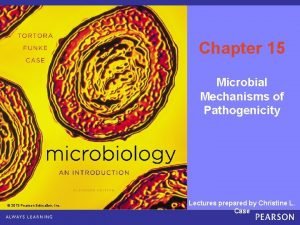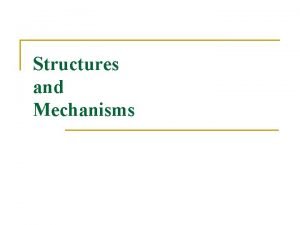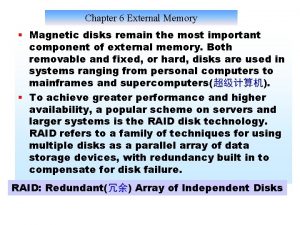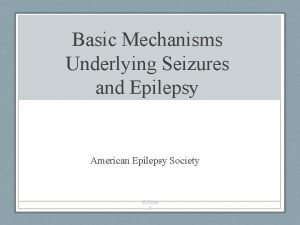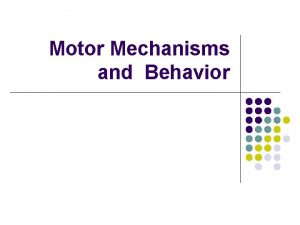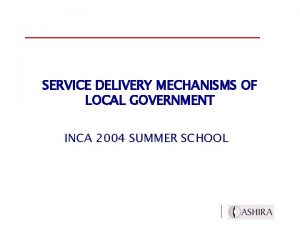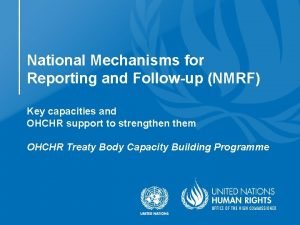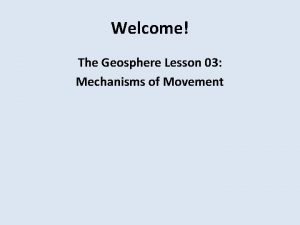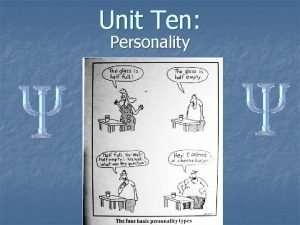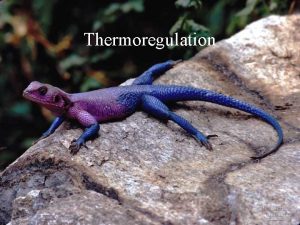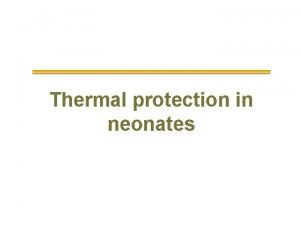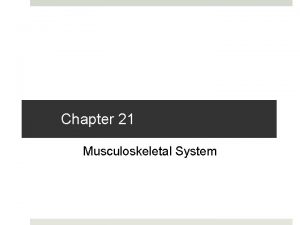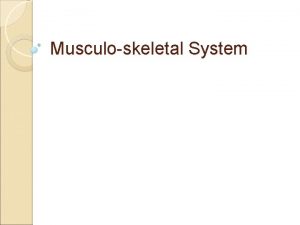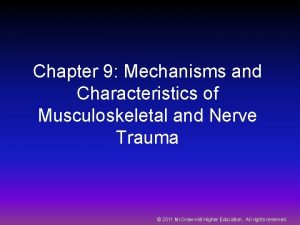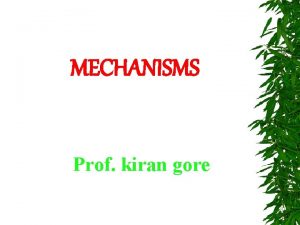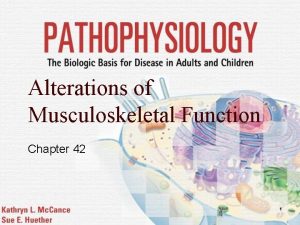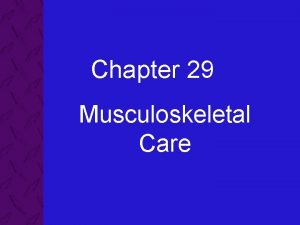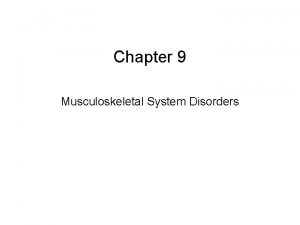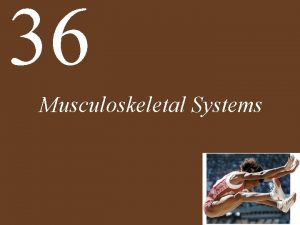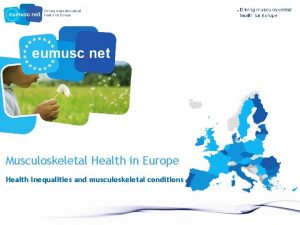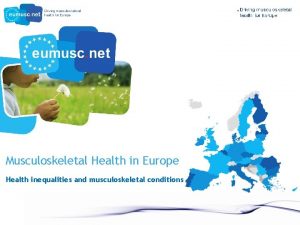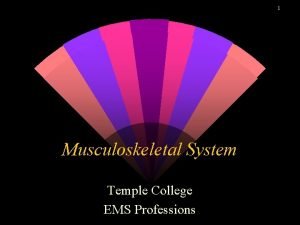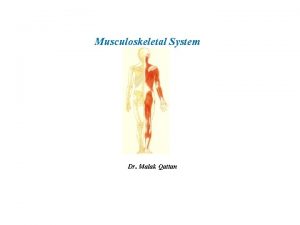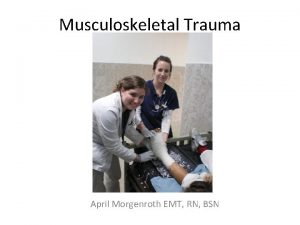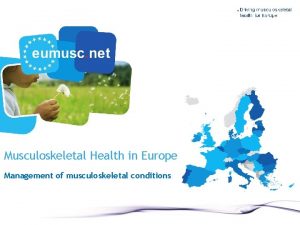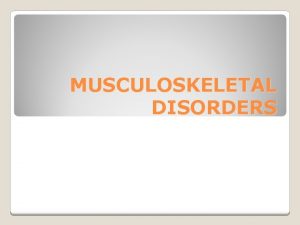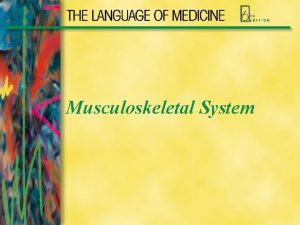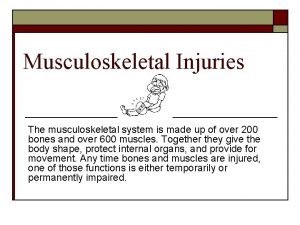Chapter 9 Mechanisms and Characteristics of Musculoskeletal and














































- Slides: 46

Chapter 9: Mechanisms and Characteristics of Musculoskeletal and Nerve Trauma © 2011 Mc. Graw-Hill Higher Education. All rights reserved.

Mechanical Injury • ______ is defined as physical injury or wound, produced by internal or external force • ________ results from force or mechanical energy that changes state of rest or uniform motion of matter © 2011 Mc. Graw-Hill Higher Education. All rights reserved.

• Tissue Properties – ____ • An external force acting on the body causing internal reactions within the tissues – _______ • Ability of a tissue to resist a load • Greater stiffness = greater magnitude load can resist – ____ • Internal resistance to a load – ______ • Internal change in tissue (i. e. length) resulting in deformation © 2011 Mc. Graw-Hill Higher Education. All rights reserved.

Figure 9 -1 © 2011 Mc. Graw-Hill Higher Education. All rights reserved.

– Body tissues are viscoelastic and contain both viscous and elastic properties – _________ • Point at which elasticity is almost exceeded is the yield point • If deformation persists, following release of load permanent or plastic changes result • When yield point is far exceeded mechanical failure occurs resulting in damage © 2011 Mc. Graw-Hill Higher Education. All rights reserved.

• Tissue Loading – ______ • Force that pulls and stretches tissue – Compression • Force that results in tissue crush – two forces applied towards one another – _______ Figure 9 -2 • Force that moves across the parallel organization of tissue © 2011 Mc. Graw-Hill Higher Education. All rights reserved.

– Bending • ____ force pairs act at opposite ends of a structure (4 points) • Three forces cause bending (3 points) • Already bowed structures encounter axial loading – ______ • Loads caused by twisting in opposite directions from opposite ends • Shear stress encountered will be perpendicular and parallel to the loads Figure 9 -2 © 2011 Mc. Graw-Hill Higher Education. All rights reserved.

Traumatic vs. Overuse Injuries • Nature of physical activity dictates that over time injury will occur • Debate over acute vs. chronic injuries – When injury is acute – something has initiated the ________ – Injury becomes chronic when it doesn’t properly heal • Could define relative to mechanism – Traumatic (i. e. a direct blow) vs. Overuse (i. e. repetitive dynamic use over time) © 2011 Mc. Graw-Hill Higher Education. All rights reserved.

Musculotendinous Unit Injuries • High incidence in _____ • Anatomical Characteristics – Composed of contractile cells that produce movement – Possess following characteristics • • Irritability Contractility Conductivity Elasticity © 2011 Mc. Graw-Hill Higher Education. All rights reserved.

Skeletal Muscle – Three types of muscle • _________ • Striated (skeletal) Figure 9 -3 © 2011 Mc. Graw-Hill Higher Education. All rights reserved.

• Muscle ______ – Stretch, tear or rip to muscle or adjacent tissue – Cause is often obscure • Abnormal muscle contraction is the result of 1)failure in reciprocal coordination of agonist and antagonist, 2) electrolyte imbalance due to profuse sweating or 3) strength imbalance – May range from minute separation of connective tissue to complete tendinous _____ or muscle rupture © 2011 Mc. Graw-Hill Higher Education. All rights reserved.

– Muscle Strain Grades • Grade I - some fibers have been stretched or actually torn resulting in tenderness and pain on active ROM, movement painful but full range present • Grade II - number of fibers have been torn and active contraction is painful, usually a depression or divot is palpable, some swelling and discoloration result • Grade III- Complete ______ of muscle or musculotendinous junction, significant impairment, with initially a great deal of pain that diminishes due to nerve damage – Pathologically, strain is very similar to contusion or sprain with capillary or blood vessel hemorrhage © 2011 Mc. Graw-Hill Higher Education. All rights reserved.

– Time required for healing may be ______ – Often involves large, force-producing muscles – Treatment and recovery may take 6 -8 weeks depending on severity – Return to play too soon could result in reinjury © 2011 Mc. Graw-Hill Higher Education. All rights reserved.

• Muscle _______ – – – • Painful involuntary skeletal muscle contraction Occurs in well-developed individuals when muscle is in shortened position Experienced at night or at rest Muscle Guarding – – Following _____, muscles within an effected area contract to splint the area in an effort to minimize pain through limitation of motion Involuntary muscle contraction in response to pain following injury • Not spasm which would indicate increased tone due to upper motor neuron lesion in the brain © 2011 Mc. Graw-Hill Higher Education. All rights reserved.

• Muscle Spasms – A reflex reaction caused by trauma – Two types • ____ - alternating involuntary muscular contractions and relaxations in quick succession • ____ - rigid contraction that lasts a period of time – May lead to muscle or tendon injuries © 2011 Mc. Graw-Hill Higher Education. All rights reserved.

• Muscle Soreness – – – Overexertion in strenuous exercise resulting in muscular ______ Generally occurs following participation in activity that individual is unaccustomed Two types of soreness 1) Acute-onset muscle soreness - accompanies fatigue, and is transient muscle pain experienced immediately after exercise 2) Delayed-onset muscle soreness (_____) - pain that occurs 24 -48 hours following activity that gradually subsides (pain free 3 -4 days later) – Potentially caused by slight microtrauma to muscle or connective tissue structures – Prevent soreness through gradual build-up of intensity © 2011 Mc. Graw-Hill Higher Education. All rights reserved.

• Tendon Injuries – Wavy parallel collagenous fibers organized in bundles - upon loading • Can produce and maintain 8, 700 - 18, 000 lbs/in 2 • Collagen straightens during loading but will return to shape after loading – Breaking point occurs at 6 -8% of increased length – Tears generally occur in muscle and not tendon © 2011 Mc. Graw-Hill Higher Education. All rights reserved.

– Repetitive stress on tendon will result in microtrauma and _______, causing fibroblasts influx and increased collagen production • Repeated microtrauma may evolve into chronic muscle strain due to reabsorption of collagen fibers • Results in weakening tendons • Collagen reabsorption occurs in early period of sports conditioning and immobilization making tissue susceptibility to injury – requires gradual loading and conditioning © 2011 Mc. Graw-Hill Higher Education. All rights reserved.

• Tendinitis – _________, with diffuse tenderness due to repeated microtrauma and degenerative changes – Obvious signs of swelling and pain – Key to treatment is _______ – May require substitution of activity in order to maintain fitness without stressing injured structure – Without proper healing condition may begin to degenerate and be referred to as tendinosis • Less inflammation, more visibly swollen with stiffness and restricted motion • Treatment involves stretching and strengthening Figure 9 -5 © 2011 Mc. Graw-Hill Higher Education. All rights reserved.

• Tenosynovitis – Inflammation of ________ – In acute case - rapid onset, crepitus, and diffuse swelling – Chronic cases result in thickening of tendon with pain and crepitus – Often occurs in long flexor tendon of the digits and the biceps tendon – Due to nature of injury anti-inflammatory agents may be helpful © 2011 Mc. Graw-Hill Higher Education. All rights reserved.

• Myofascial Trigger Points – Discrete, hypersensitive nodule within tight band of ____________ – Classified as latent or active – Develop as the result of mechanical stress • Either acute trauma or microtrauma • May lead to development of stress on muscle fiber = formation of trigger points – Latent trigger point • Does not cause spontaneous pain • May restrict movement or cause muscle weakness • Become aware of presence when pressure is applied © 2011 Mc. Graw-Hill Higher Education. All rights reserved.

– Active trigger point • • • Causes pain at rest Applying pressure = pain = jump sign Tender to palpation with referred pain Tender point vs. trigger point Found most commonly in muscles involved in postural support © 2011 Mc. Graw-Hill Higher Education. All rights reserved.

• _________ – Result of sudden ____ to body – Can be both deep and superficial – ______ results from blood and lymph flow into surrounding tissue • Localization of extravasated blood into clot, encapsulated by connective tissue • Speed of healing dependent on the extent of damage – Chronically inflamed and contused tissue may result in generation of calcium deposits (myositis ossificans) • Prevention through protection of contused area with padding © 2011 Mc. Graw-Hill Higher Education. All rights reserved.

© 2011 Mc. Graw-Hill Higher Education. All rights reserved.

• Atrophy and Contracture – _____ is wasting away of muscle due to immobilization, inactivity, or loss of nerve functioning – _______ is an abnormal shortening of muscle where there is a great deal of resistance to passive stretch • Generally the result of a muscle injury which impacts the joint, resulting in accumulation of scar tissue © 2011 Mc. Graw-Hill Higher Education. All rights reserved.

Synovial Joints Injuries • Each joint has both _____ or articular cartilage and a fibrous connective tissue capsule • Additional synovial joint characteristics – Capsule and ligaments for support – Capsule is lined with synovial membrane – Hyaline cartilage – Joint cavity with synovial fluid – Blood and nerve supply with muscles crossing joint – Menisci (fibrocartilage)© 2011 Mc. Graw-Hill Higher Education. All rights reserved.

Figure 9 -8 © 2011 Mc. Graw-Hill Higher Education. All rights reserved.

• Ligament _____ – Result of traumatic joint twist that causes stretching or tearing of connective tissue – Graded based on the severity of injury • Grade I - some pain, minimal loss of function, no abnormal motion, and mild point tenderness • Grade II - pain, moderate loss of function, swelling, and instability with tearing and separation of ligament fibers • Grade III - extremely painful, inevitable loss of function, severe instability and swelling, and may also represent subluxation © 2011 Mc. Graw-Hill Higher Education. All rights reserved.

• Can result in joint effusion and swelling, local temperature increase, pain and point tenderness, ecchymosis (change in skin color) and possibly an avulsion fracture • Greatest difficulty with grade 1 & 2 sprains is restoring stability due to stretched tissue and inelastic scar tissue which forms • To regain joint stability strengthening of muscles around the _____ is critical © 2011 Mc. Graw-Hill Higher Education. All rights reserved.

• Dislocations and Subluxations – Result in separation of bony articulating surfaces – _________ • Partial dislocations causing incomplete separation of two bones • Bones come back together in alignment – _________ • High level of incidence in fingers and shoulder • Occurs when at least one bone in a joint is forced out of alignment and must be manually or surgically reduced • Gross deformity is typically apparent with bilateral comparison revealing asymmetry © 2011 Mc. Graw-Hill Higher Education. All rights reserved.

– Dislocation (cont. ) • ______________ of the joint are disrupted • Joint often becomes susceptible to subsequent dislocations • _____ is the only absolute diagnostic technique (able to see bone fragments from possible avulsion fractures, disruption of growth plates or connective tissue) • Dislocations (particularly first time) should always be considered and treated as a fracture until ruled out • “Once a dislocation, always a dislocation” Figure 9 -9 © 2011 Mc. Graw-Hill Higher Education. All rights reserved.

• Osteoarthritis – Wearing away of ______ cartilage as a result of normal use – Changes in joint mechanics lead to joint degeneration – Commonly affects weight bearing joints but can also impact shoulders and cervical spine – Symptoms include pain (as the result of friction), stiffness, prominent morning pain, localized tenderness, creaking, grating – Either generalized joint pain or localized to one side of the joint Figure 9 -10 © 2011 Mc. Graw-Hill Higher Education. All rights reserved.

– ________ • Bursa are __________that develop in areas of friction • Sudden irritation cause acute bursitis, while overuse and constant external compression cause chronic bursitis • Signs and symptoms include swelling, pain, and some loss of function • Repeated trauma can lead to calcification and degeneration of internal bursa linings Figure 9 -11 © 2011 Mc. Graw-Hill Higher Education. All rights reserved.

– Capsulitis and Synovitis • ________ is the result of repeated joint trauma • Synovitis can occur acutely but will also develop following mistreatment of joint injury • Chronic synovitis can result in edema, thickening of the synovial lining, exudation can occur and a fibrous underlying develops • Motion may become restricted and joint noises may develop © 2011 Mc. Graw-Hill Higher Education. All rights reserved.

Bone Injuries • Anatomical Characteristics – Dense connective tissue matrix – Outer compact tissue – Inner porous cancellous bone including Haversian canals Figure 9 -12 © 2011 Mc. Graw-Hill Higher Education. All rights reserved.

– Bone Functions • • • Body support Organ protection Movement (through joints and levers) Calcium storage Formation of blood cells (hematopoiesis) – Types of Bone • • • Classified according to shape _______- skull, ribs, scapulae Irregular bones - vertebrae and skull _______- wrist and ankle Long bones (humerus, ulna, tibia, radius, fibula, femur) - bones most commonly injured © 2011 Mc. Graw-Hill Higher Education. All rights reserved.

– Gross Structures • ______ -shaft - hollow and cylindrical - covered by compact bone - medullary cavity contains yellow marrow and lined by endosteum • Epiphysis - composed of cancellous bone and has hyaline cartilage covering - provides areas for muscle attachment • ______ - dense, white fibrous covering which penetrates bone via Sharpey’ fibers - contains blood vessels and osteoblasts © 2011 Mc. Graw-Hill Higher Education. All rights reserved.

• Bone Fractures – Classified as either _________ • Closed fractures are those where there is little movement or displacement • Open fractures involve displacement of the fractured ends and breaking through the surrounding tissue – Serious condition if not managed properly – Signs & symptoms • Deformity, pain, point tenderness, swelling, pain on active and passive movements • Possible crepitus • X-ray will be necessary for definitive diagnosis © 2011 Mc. Graw-Hill Higher Education. All rights reserved.

– Mechanism of Injury • Fracture may be direct (at point of force application) or indirect • Sudden violent and forceful muscle contraction – Types of fractures • • _____ Comminuted Linear Transverse Oblique _____ Impacted Depressed Figure 9 -13 © 2011 Mc. Graw-Hill Higher Education. All rights reserved.

– __________ • No specific cause but with a number of possible causes – Overload due to muscle contraction, altered stress distribution due to muscle fatigue, changes in surface, rhythmic repetitive stress vibrations • Bone becomes susceptible early in training due to increased muscular forces and initial remodeling and resorption of bone • Progression involves, focal microfractures, periosteal or endosteal response (stress fx) linear fractures and displaced fractures • Early detection is difficult, ______ is useful, x-ray is effective after several weeks © 2011 Mc. Graw-Hill Higher Education. All rights reserved.

• Typical causes include – – – Coming back to competition too soon after injury Changing events without proper conditioning Starting initial training too quickly Changing training habits (______, shoes…. etc) Variety of postural and foot conditions • Signs and symptoms – Focal tenderness and pain, (early stages) – Pain with activity, (later stages) with pain becoming constant and more intense, particularly at night, (exhibit a positive percussion tap test) • Common sites involve tibia, fibula, metatarsal shaft, calcaneus, femur, pars interarticularis, ribs, and humerus • Management varies between individuals, injury site and extent of injury © 2011 Mc. Graw-Hill Higher Education. All rights reserved.

• Nerve Injuries – Compression and tension are primary mechanisms – May be acute or chronic – Physical trauma causes pain and can result in a host of sensory responses (pinch, burn, tingle, muscle weakness, radiating pain) – Long term problems can go from minor nerve problems to paralysis – _________ • • Interruption in conduction through nerve fiber Brought about via compression or blunt trauma Impact motor more than sensory function Temporary loss of function – Pain can be referred as well © 2011 Mc. Graw-Hill Higher Education. All rights reserved.

Body Mechanics and Injury Susceptibility • Body moves very effectively in upright position - able to overcome great forces even with inefficient lever system • Body must overcome inertia, muscle viscosity and unfavorable angles of pull • Mechanical reasons for injury - ________________________ • Body build, structural make-up, habitual incorrect application of skill may also predispose individual to injury © 2011 Mc. Graw-Hill Higher Education. All rights reserved.

• Microtrauma and Overuse Syndrome – Injuries as a result of abnormal and repetitive stress and microtraumas fall into a class with certain identifiable syndromes – Frequently result in limitation or curtailment of sports involvement – Often seen in ________________________________ – Some of these injuries while small can be debilitating – Repetitive overuse and stress injuries include • Achilles tendinitis, shin splints, stress fx, Osgood. Schlatter's disease, runner’s and jumper’s knee, patellar chondromalacia and apophyseal avulsion © 2011 Mc. Graw-Hill Higher Education. All rights reserved.

• ___________ – Often an underlying cause of injury – May be the result of unilateral muscle or bony and soft tissue asymmetries – Sports activities may cause asymmetries to develop – Results in poor pathomechanics – Imbalance is manifested by postural deviations as body tries to regain balance relative to Co. G • May be primary cause of injury © 2011 Mc. Graw-Hill Higher Education. All rights reserved.

– Injury generally becomes ______ and athletic participation must stop – Athletic trainer should attempt to correct _______ conditions – Postural conditions can make individual exceedingly more prone to injury © 2011 Mc. Graw-Hill Higher Education. All rights reserved.
 Chapter 6 musculoskeletal system diseases and disorders
Chapter 6 musculoskeletal system diseases and disorders Chapter 21 the musculoskeletal system
Chapter 21 the musculoskeletal system Chapter 15 musculoskeletal system practical
Chapter 15 musculoskeletal system practical Chapter 41 musculoskeletal care modalities
Chapter 41 musculoskeletal care modalities Buck's extension traction
Buck's extension traction Types of joint movement
Types of joint movement Unit 41 musculoskeletal system
Unit 41 musculoskeletal system Musculoskeletal system
Musculoskeletal system Contoh soal koding icd 10
Contoh soal koding icd 10 Kode icd 10 gout arthritis
Kode icd 10 gout arthritis Musculoskeletal fitness
Musculoskeletal fitness Work related musculoskeletal disorders definition
Work related musculoskeletal disorders definition Musculoskeletal pronounce
Musculoskeletal pronounce Medical
Medical Diseases of the musculoskeletal system
Diseases of the musculoskeletal system Assessment of the musculoskeletal system
Assessment of the musculoskeletal system Muscle strength scale
Muscle strength scale Musculoskeletal system
Musculoskeletal system West coast musculoskeletal
West coast musculoskeletal ömpsq
ömpsq Cephalohematoma
Cephalohematoma Musculoskeletal integrity
Musculoskeletal integrity Thank you pictures for presentation
Thank you pictures for presentation Spine pathology
Spine pathology Musculoskeletal
Musculoskeletal Sathish srinivasan
Sathish srinivasan Cochrane musculoskeletal group
Cochrane musculoskeletal group Mri
Mri Objective data for musculoskeletal system
Objective data for musculoskeletal system Chapter 15 microbial mechanisms of pathogenicity
Chapter 15 microbial mechanisms of pathogenicity Chapter 15 microbial mechanisms of pathogenicity
Chapter 15 microbial mechanisms of pathogenicity Full virtualization vs paravirtualization
Full virtualization vs paravirtualization Mechanism and structure
Mechanism and structure Read and write mechanism of magnetic disk
Read and write mechanism of magnetic disk Basic mechanisms underlying seizures and epilepsy
Basic mechanisms underlying seizures and epilepsy Motor mechanisms
Motor mechanisms Security services in cryptography
Security services in cryptography Internal service delivery mechanisms
Internal service delivery mechanisms Security attacks services and mechanisms
Security attacks services and mechanisms Chapter 11 managing weight and eating behaviors
Chapter 11 managing weight and eating behaviors National mechanisms for reporting and follow-up
National mechanisms for reporting and follow-up Mechanisms of movement lab report
Mechanisms of movement lab report Behaviorist theory of personality
Behaviorist theory of personality Homeostasis mechanisms for regulation of body temperature
Homeostasis mechanisms for regulation of body temperature Evaporative heat loss newborn
Evaporative heat loss newborn Ego defense mechanisms examples
Ego defense mechanisms examples Th and tc cells
Th and tc cells


